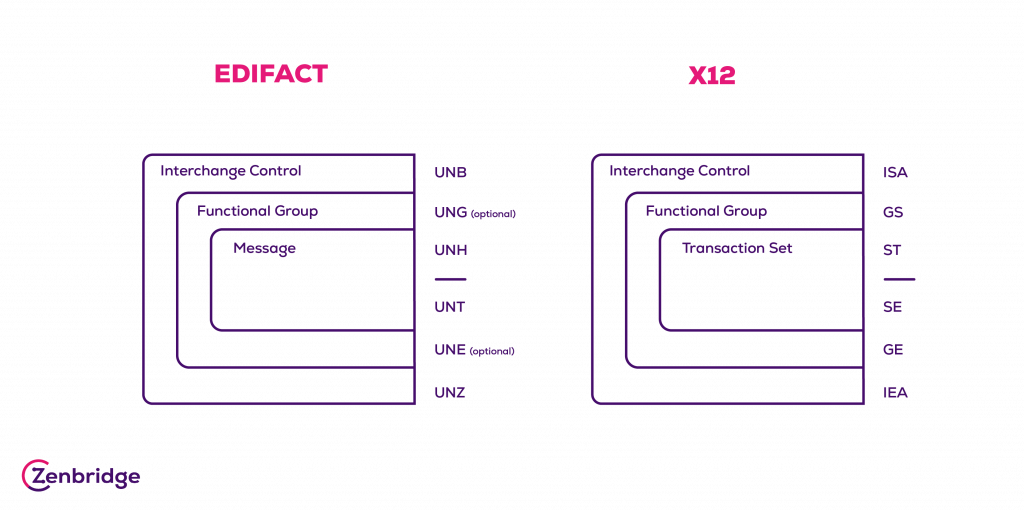
Difference Between EDIFACT and X12
On January 3, 2023 by Shivam RawatEDI standards have distinct specifications to implement EDI, and they may vary from one company to another based on their business requirements. The two most common standards are EDIFACT and X12. EDIFACT (EDI for Administration, Commerce, and Transport) is an EDI standard introduced by the United Nations/Economic Commission for Europe based on internationally agreed standards, directories, and EDI guidelines. X12, also known as ANSI X12, is an ANSI(American National Standards Institute)-accredited EDI standard for developing, implementing, and managing B2B transactions.
EDIFACT and X12 are common EDI standards for B2B data communication that are very similar in processing EDIs, but some attributes set them apart. In this article, we will be discussing these two standards based on factors that make them different from each other.
Comparing EDIFACT and X12
Use Case
One of the differences between EDIFACT and X12 is their geographical region of use. EDIFACT is the primarily used EDI standard by companies in Europe and Asia, whereas X12 is the common EDI standard in the US and North America.
Both EDI standards are widespread across different industries and sectors. Today, the healthcare market uses X12 to create HIPAA-compliant documents, which EDIFACT does not support. Similarly, EDIFACT is more prevalent in the agriculture and public sector. Nevertheless, both EDIFACT and X12 play equivalent roles in other industries, such as retail, transport, logistics, government, and supply chain.
Structure
EDIFACT and X12 documents have a similar message structure but vary in terminology. To understand this better, here is a comparison of the formats of both EDI standards.

EDIFACT and X12 have segments that store all necessary values to form a complete EDI file. These ‘Control Segments’ are – Interchange Control, Functional Group, and Transaction Set.
Interchange Control is the only segment with a fixed length record. This segment helps the EDI systems derive the sender, receiver, element separator, sub-element separators, and segment terminators used during EDI transformation. It consists of a header and a footer that envelopes the Functional Group and Transaction Set. In EDIFACT, the Interchange header and footer are UNB and UNZ, respectively, and ISA and IEA in X12.
Functional Group, also known as the inner envelope, can contain one or multiple Transaction Sets that are of the same type, which can be batched together into one transmission. It is a mid-level EDI envelope with a header and footer pair. In EDIFACT, the header and footer are UNG and UNE, and in X12, they are GS and GE. Some EDIFACT standards, like TRADACOMS do not use functional groups.
Transaction Set is similar to a paper document containing information about a purchase order, ship notices, or invoice. Each transaction set has a transaction set ID containing a three-digit identifier in X12. In EDIFACT, this innermost envelope is called a Message envelope, which contains the EDI document/message and has a six-letter identifier. The header and footer for a Message in EDIFACT are UNH and UNT, and in X12 Transaction Set, they are ST and SE.
Document Style
EDIFACT uses letters to define the documents, while X12 uses numbers. For example, EDIFACT and X12 use INVOIC and 810 for the invoice, DELFOR and 830 for the planning schedule, and ORDERS and 850 for the purchase order, respectively. Note that the EDIFACT standard uses six letters, and X12 uses 3-digit numbers.
Composite Elements
Composite Elements consist of sub-elements that are smaller units of data elements. In a sub-element, a colon(:) can act as a separator to begin a new sub-element or separate two sub-elements. Composite Element determines the information, such as the item number in the purchase order and the location of the item. It has extensive use in EDIFACT compared to X12, where its usage depends only on the specifications agreed between the trading parties.
Segment
The Segment contains a group of elements or composite data elements that combines to communicate useful data. For example, BEG is a segment in an EDI doc that defines the “Beginning Segment of Purchase Order” field. It will contain elements such as Transaction Set Purpose Code, Purchase Order Type Code, Purchase Order Number, Release Number, and Date.
EDIFACT and X12 can both have customized segments and elements based on strictly mandated specifications discussed between you and your trading partner.
Terminators and Separators
EDIFACT and X12 use their own special characters to distinguish elements and segments. These delimiters of EDIFACT are called Separators. Most commonly, EDIFACT uses an apostrophe(‘) between segments, a plus sign(+) between elements, and a colon(:) between composite elements. In comparison, X12 denotes them as Terminators, entering a tilde(~) between segments and a star(*) between elements. However, both standards can use custom delimiters based on the agreed-upon specifications between trading parties.
Security Authentication
EDIFACT has four main security standards – ISO 9735-5, ISO 9735-6, ISO 9735-7, and ISO 9735-9.
- ISO9735-5 – Security rules for Batch EDI (authenticity, integrity, and non-repudiation of origin).
- ISO9735-6 – Secure authentication and acknowledgment message (message type – AUTACK).
- ISO9735-7 – Security rules for batch EDI (confidentiality).
- ISO9735-9 – Security key and certificate management message (message type – KEYMAN).
X12 maintains high security for EDI using ASC X12.58, which ensures encrypted file transfers from the source to the destination. It manages authentication, compression, and transmission while maintaining the originality of the document so it reaches the recipients without tampering with the data during the exchange.
EDIFACT or X12? The Right EDI for Your Business
There isn’t any evidence that says one EDI standard is better than the other. Both EDIFACT and X12 can be challenging due to their complexity, which is why it is important to understand how these standards work. Learning the structure and implementation of EDI standards will help you achieve long-term EDI goals in unexpectedly shorter durations and expenses.

Leave a Reply